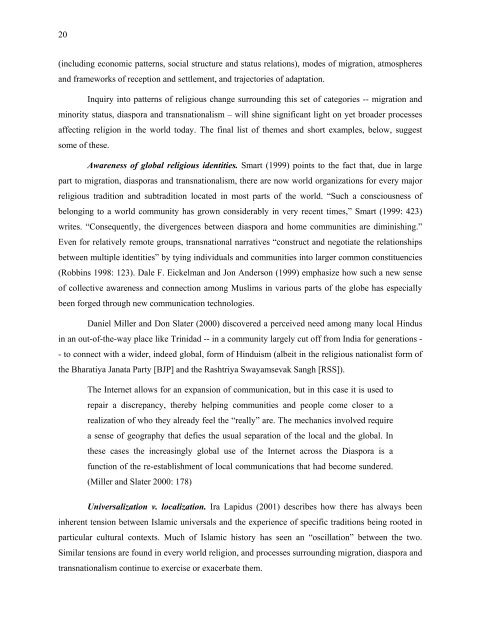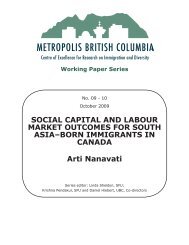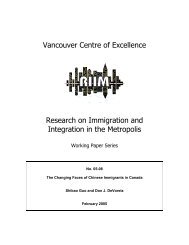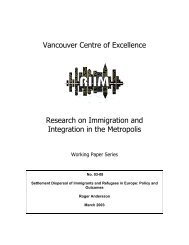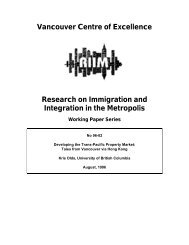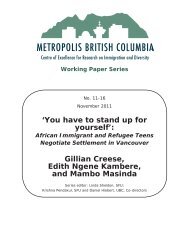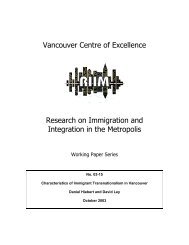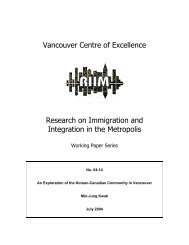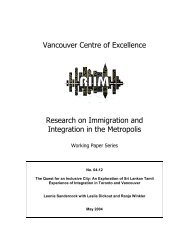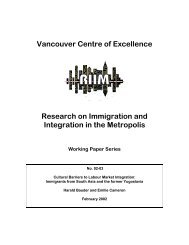Religion in Migration, Diasporas and Transnationalism - Metropolis BC
Religion in Migration, Diasporas and Transnationalism - Metropolis BC
Religion in Migration, Diasporas and Transnationalism - Metropolis BC
Create successful ePaper yourself
Turn your PDF publications into a flip-book with our unique Google optimized e-Paper software.
20<br />
(<strong>in</strong>clud<strong>in</strong>g economic patterns, social structure <strong>and</strong> status relations), modes of migration, atmospheres<br />
<strong>and</strong> frameworks of reception <strong>and</strong> settlement, <strong>and</strong> trajectories of adaptation.<br />
Inquiry <strong>in</strong>to patterns of religious change surround<strong>in</strong>g this set of categories -- migration <strong>and</strong><br />
m<strong>in</strong>ority status, diaspora <strong>and</strong> transnationalism – will sh<strong>in</strong>e significant light on yet broader processes<br />
affect<strong>in</strong>g religion <strong>in</strong> the world today. The f<strong>in</strong>al list of themes <strong>and</strong> short examples, below, suggest<br />
some of these.<br />
Awareness of global religious identities. Smart (1999) po<strong>in</strong>ts to the fact that, due <strong>in</strong> large<br />
part to migration, diasporas <strong>and</strong> transnationalism, there are now world organizations for every major<br />
religious tradition <strong>and</strong> subtradition located <strong>in</strong> most parts of the world. “Such a consciousness of<br />
belong<strong>in</strong>g to a world community has grown considerably <strong>in</strong> very recent times,” Smart (1999: 423)<br />
writes. “Consequently, the divergences between diaspora <strong>and</strong> home communities are dim<strong>in</strong>ish<strong>in</strong>g.”<br />
Even for relatively remote groups, transnational narratives “construct <strong>and</strong> negotiate the relationships<br />
between multiple identities” by ty<strong>in</strong>g <strong>in</strong>dividuals <strong>and</strong> communities <strong>in</strong>to larger common constituencies<br />
(Robb<strong>in</strong>s 1998: 123). Dale F. Eickelman <strong>and</strong> Jon Anderson (1999) emphasize how such a new sense<br />
of collective awareness <strong>and</strong> connection among Muslims <strong>in</strong> various parts of the globe has especially<br />
been forged through new communication technologies.<br />
Daniel Miller <strong>and</strong> Don Slater (2000) discovered a perceived need among many local H<strong>in</strong>dus<br />
<strong>in</strong> an out-of-the-way place like Tr<strong>in</strong>idad -- <strong>in</strong> a community largely cut off from India for generations -<br />
- to connect with a wider, <strong>in</strong>deed global, form of H<strong>in</strong>duism (albeit <strong>in</strong> the religious nationalist form of<br />
the Bharatiya Janata Party [BJP] <strong>and</strong> the Rashtriya Swayamsevak Sangh [RSS]).<br />
The Internet allows for an expansion of communication, but <strong>in</strong> this case it is used to<br />
repair a discrepancy, thereby help<strong>in</strong>g communities <strong>and</strong> people come closer to a<br />
realization of who they already feel the “really” are. The mechanics <strong>in</strong>volved require<br />
a sense of geography that defies the usual separation of the local <strong>and</strong> the global. In<br />
these cases the <strong>in</strong>creas<strong>in</strong>gly global use of the Internet across the Diaspora is a<br />
function of the re-establishment of local communications that had become sundered.<br />
(Miller <strong>and</strong> Slater 2000: 178)<br />
Universalization v. localization. Ira Lapidus (2001) describes how there has always been<br />
<strong>in</strong>herent tension between Islamic universals <strong>and</strong> the experience of specific traditions be<strong>in</strong>g rooted <strong>in</strong><br />
particular cultural contexts. Much of Islamic history has seen an “oscillation” between the two.<br />
Similar tensions are found <strong>in</strong> every world religion, <strong>and</strong> processes surround<strong>in</strong>g migration, diaspora <strong>and</strong><br />
transnationalism cont<strong>in</strong>ue to exercise or exacerbate them.


